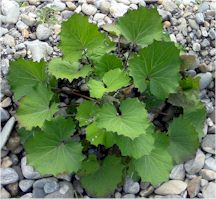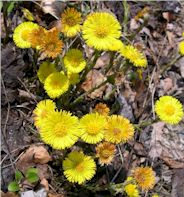 |
 |
The Coltsfoot, which grows abundantly throughout England in places of moist, heavy soil, especially along the sides of our raised railway banks, has been justly termed "nature's best herb for the lungs, and her most eminent thoracic." Its seeds are supposed to have lain dormant from primitive times, where our railway cuttings now upturn them and set them growing anew; and the rotting foliage of the primeval herb by retaining its juices, is thought to have promoted the
development and growth of our common earthworm.
The botanical name of Coltsfoot is Tussilago farfara, signifying tussis ago, "I drive away a cold"; and farfar, the white poplar tree, which has a similar leaf. It is one of the Composite order, and the older authors named this plant, Filius ante patrem "the son before the father," because the flowers appear and wither before the leaves are produced. These flowers, at the very beginning of Spring, stud the banks with gay, golden, leafless blossoms,
each growing on a stiff scaly stalk, and resembling a dandelion in miniature. The leaves, which follow later on, are made often into cigars, or are smoked as British herbal tobacco, being mixed for this purpose with the dried leaves and flowers of the eye-bright, buckbean, betony, thyme, and lavender, to which some persons add rose leaves, and chamomile flowers. All these are rubbed together by the hands into a coarse powder, Coltsfoot forming quite one-half of the same; and
this powder may be very beneficially smoked for asthma, or for spasmodic bronchial cough. Linnoeus said, "Et adhuc hodie plebs in Sueci?instar tabaci contra tussim fugit" "Even to-day the Swiss people cure their coughs with Coltsfoot employed like tobacco." When the flowers are fully blown and fall off, the seeds with their "clock" form a beautiful head of white flossy silk, and if this flies away when there is no wind it is said to be a sure sign of coming rain. The
Goldfinch often lines her nest with the soft pappus of the Coltsfoot. In Paris the Coltsfoot flower is painted on the doorposts of an apothecary's house.
From earliest times, the plant has been found helpful in maladies of the chest. Hippocrates advised it with honey for "ulcerations of the lungs." Dioscorides, Pliny, and Galen, severally commended the use of its smoke, conducted into the mouth through a funnel or reed, for giving ease to cough and difficult breathing; they named it breechion, from breex, a cough.
In taste, the leaves are harsh, bitter, and mucilaginous. They appear late in March, being green above, with an undersurface which is white, and cottony. Sussex peasants esteem the white down of the leaves as a most valuable medicine.
All parts of the plant contain chemically tannin, with a special bitter principle, and free mucilage; so that the herb is to be considered emollient, demulcent, and tonic. Dr. Cullen employed a decoction of the leaves with much benefit in scrofula, where the use of sea water had failed. And Dr. Fuller tells about a girl cured of twelve scrofulous sores, by drinking daily, for four months, as much as she could of Coltsfoot tea, made so strong from the leaves as to be sweet and
glutinous. A modern decoction is prepared from the herb with boiling water poured on the leaves, and with liquorices root and honey added.
But, "hark! I hear the pancake bell," said Poor Richard in his almanac, 1684; alluding to pancakes then made with Coltsfoot, like tansies, and fried with sagged butter.
A century later it was still the fashion to treat consumptive young women with quaint remedies. Mrs. Delaney writes in 1758, "Does Mary cough in the Night? two or three snails boiled in her barley water may be of great service to her."
Again, the confectioner provides Coltsfoot rock, concocted in fluted sticks of a brown color, as a sweetmeat, and flavored with some essential oil--as aniseed, or dill--these sticks being well beloved by most schoolboys. The dried leaves, when soaked out in warm water, will serve as an excellent emollient poultice. A certain preparation, called "Essence of Coltsfoot," found great favour with our grand sires for treating their colds. This consisted of Balsam of Tolu and
Friar's Balsam in equal parts, together with double the quantity of Spirit of Wine. It did not really contain a trace of Coltsfoot, and the nostrum was provocative of inflammation, because of the spirit in excess. Dr. Paris said: "And this, forsooth, is a pectoral for coughs! If a patient with a catarrh should recover whilst using such a remedy, I should certainly designate it a lucky escape, rather than a skilful cure." Gerard wrote about Coltsfoot: "The fume of the dried
leaves, burned upon coals, effectually helpeth those that fetch their winde thicke, and breaketh without peril the impostumes of the brest"; also "the green leaves do heal the hot inflammation called Saint Anthony's fire."
The names of the herb Coltsfoot, and Horsehoof are derived from the shape of the leaf. It is likewise known as Asses' foot, and Cough wort; also as Foal's foot, and Bull's foot, Hoofs, and (in Yorkshire) Cleats.
To make an infusion or decoction of the plant for a confirmed cough, or for chronic bronchitis, pour a pint of boiling water on an ounce of the dried leaves and flowers, and take half a teacupful of it when cold three or four times in the day. The silky down of the seed-heads is used in the Highlands for stuffing pillows, and the presence of coal is said to be indicated by an abundant growth of the herb.
Another species, the Butter bur (Tussilago petasites), is named from petasus, an umbrella, or a broad covering for the head. It produces the largest leaves of any plant in Great Britain, which sometimes measure three feet in breadth. This plant was thought to be of great use in the time of the plague, and thus got the names of Pestilent wort, Plague flower and Bog Rhubarb. Both it, and the Coltsfoot, are specific remedies (H.) for severe and obstinate neuralgia
in the small of the back, and the loins, a medicinal tincture being prepared from each herb.
Herb Simples
The Primitive Simplers presented here show the way of life in other generations, it is not suggested or recommended trying them yourself. |
|
Garden
Herbs
Home
History of Herbs
Herb Gardening
Herbs for Beginners
Drying & Preserving Herbs
Indoor Herb Gardening
Herb Garden
Hints & Tips
Herbal
Cooking
Herb Chart
Using Herbs
Culinary Herbs
Herb
Oil and Vinegar
Herb Teas
Herb Candy
Herb Jelly
Herb Simples
Preface
Introduction
Alphabetical Listing

Trade
Recipes Online
Share your Recipes with others!!
|



